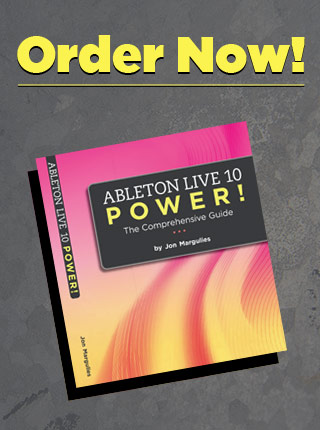There are a few things to bear in mind when mapping Live’s scene navigators. The up/down arrows are pretty straightforward, but the numeric control, not as much. Unlike most controls in Live which work perfectly well when being sent absolute MIDI data, this control is designed to be controlled by relative MIDI data. Absolute MIDI […]
NAVIGATING THE MEGA-SET, pt. 3
OK, a little more on navigation: The last tip was all about how using an absolute (0-127) MIDI CC to control scene navigation is less than ideal, but it turns out there’s also a way you can use that to your advantage. The trick is in knowing that sending a 0 or a 127 to […]
RELATIVE CLIP LAUNCHERS
So, since I’ve gotten so far into the subject of scene navigation, the question inevitably follows: once you’ve gotten to the desired location in your set, then what? How do you launch them clips? The answer lies in the MIDI (or Keyboard) map. While you’re in map mode, take a look at the area directly […]
THE SAMPLE BUS
Over the last few tips, I’ve been breaking down every element of my performance template that hasn’t come up in previous tips. When I’m all done, we’ll spend a little time looking at how it’s all put together. If you’ve been following along, something you’ll know about my set is that I’m regularly mashing a […]
SETTING UP A BUS
For those of you out there who aren’t masters of Live’s signal routing, I’m going to take a moment to break down how you create a bus track like the Sample Bus that I talked about in the last tip. In this case, the term bus refers to a track that is used to combine […]
PRINT THE RETURN
Now that I’ve added some satisfying junk to my drum sound, I’m going to render the processed signal to an audio file. (I’ll discuss why in a moment.) Remember that all of the processing from the prior tips is happening in Return A: To Print Return A to an audio file, open up the Export […]
EXTRACT CHAINS
I’m a big fan of Drum Racks. Every track I do has its main beat programmed using one. There are lots of reasons for this, but a big one is the Extract Chains command, which is accessed by right-clicking in the Chain List: In the above example, this command will remove the chain called OB-Hat […]
DRUM EDITING WORKFLOW
In the previous tip I mentioned that I extract the drum rack chains once I’ve got a basic arrangement laid out. There’s another piece to my workflow, though: I usually do one pass of drum editing before extracting the chains. After the arrangement is laid out, I find spots to create additional variations – such […]
GROUP THE EXTRACTED
Before you extract the Chains in your Drum Rack into separate chains, make a note of the volume of the track the Drum Rack is in: When you extract a chain, the volume of the new track will be set to zero. In the example above, this means that extracting a chain from this Drum […]
GROUP IN A GROUP
Every now and then you’ll bump into the problem that you can’t have a Group track within a Group track (the way you can nest Racks within each other). For example, you might want to group a set of keyboard parts together, but one of the parts is made up of two tracks you’ve layered […]





